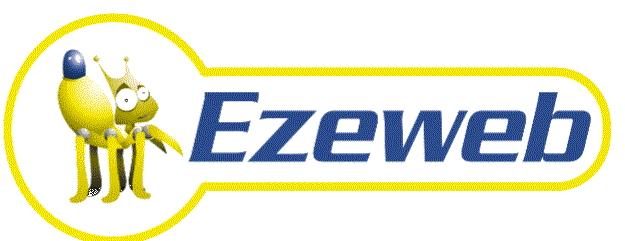

How it works
As owner of your site you will have given password protected access to the administration and web design software that runs on our computers. Using this software you can build or adapt the pages of your site to contain the text and graphics you require, simply by filling the forms that appear on your screen. The following sections consider various technical aspects of this.
Ftp / html / frontpage / dreamweaver / programming / javascript etc.
You need none of these! The web base forms do it all for you. Transfer of graphic files is achieved via the forms, thus obviating the need for ftp transfers. The Ezeweb software builds the HTML code for you. You can however, embellish your site by including HTML code within any text you put in place.
Domain names
The standard URL for your web site will be www.ezeweb.co.uk/"yoursitename". We can arrange for you to have your own URL e.g. www."yoursitename".co.uk , but this is not available via the free trial deal.
Email to you can be addressed to "yoursitename"( at )ezeweb.co.uk and either collected via
pop3 from your email program, or delivered to another email account you may have.
If you have your own URL with us, email can be addressed to xxxxxx( at )"yoursitename".co.uk where xxxxxx
can be any number of different names. (Use the email software on your PC to segregate received
mail into different folders according to the value of xxxxxx, e.g. sales, orders etc.).
email sent from your PC will continue to be handled by your ISP.
Background graphics
You may choose to retain the background that comes with the site or define your own. If you keep the
size of the image down, then download time for visitors to your site is minimised, and the image is
repeated (tiled) to fill the page. Since the text on your pages will appear over the background, it
is important to ensure the net result is readable.
This is generally achieved by maximisng the
contrast between the background and text colours, and minimising the contrast and coulor variation within
the background image. Remember that the same background image is used on a number of different information
pages, so the its suitability should be checked in all cases.
Logos
Your logo is a key element in making the site recognisably yours. You can use either a .gif or .jpg file, and typically this will have a transparent background to achieve the best visual impact. If your logo looks good on an A4 sheet, it probably wont need resizing.
Navigation
The various pages of your site are accessible by hot links on a navigation menu on the left of the window, and also via links at the bottom of the pages.
Updating/refreshing
When applying changes to your site, enter the new information, or use the drop down menus to select a valid entry.
Then click the 'Change eShowcase Settings' button.
Even though you make changes in the settings, they will not show up on your site until your run the pages affected
by the changes, through the 'edit pages' option.
Changes in settings are applied when pages are rebuilt.
This means that if you select 'yes' for build order form, you will need to use the menu option 'edit main pages'
to force each of the main pages to be rebuilt with the latest settings.
Most Internet browsers 'cache' or store in memory Internet pages the first time they are viewed.
If they are viewed a second time, the pages are usually shown as stored in memory, rather than
as they exist on the web sites.
This can cause you to think a page has not been updated when it really has.
If there is any doubt, press and hold the shift button on your keyboard, and then click the
'refresh' or 'reload' button on your browser. This will force a page reload.
Testing
After making any changes, you should verify that all the pages work as you expect them to, bearing in mind the points made above about flushing old information from your browser cache etc. Testing is particularly important if you have embedded HTML code into any of you text, ideally you should test for (or be aware that) different browsers can produce differing results in complex situations.
This is a summarised list of items that can be configured relating to the look and feel of your site:
The order form has many items that you can configure:
Secure order form.
If you have enabled your site to process orders, your customers' details will be protected by the secure ordering system, preventing the information being intercepted by third parties.
Processing orders.
When you receive customer orders, you process them much as you would had you received them any other way except that you will have them in electronic form, so re-keying of the information into your own system, or transcription errors can be avoided e.g. by cut and paste techniques.